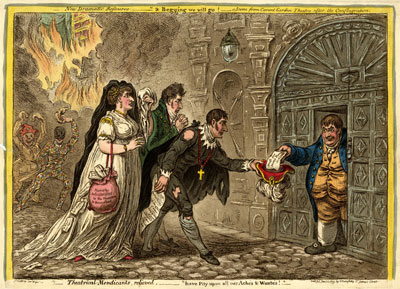Theatrical Mendicants, Relieved
The unlikely mendicants shown here are three members of arguably the most famous acting family in Britain: the distinguished Shakespearian actor, John Philip Kemble; his older sister, Sarah Siddons, and (most likely) his younger brother, Charles Kemble.

© Trustees of the British Museum
The first part of the title can be read in two ways: 1) mendicants i.e. beggars who are associated with the theater; and 2) mendicants who play up their poverty for dramatic effect. The first meaning is simply a matter of fact; these are the Kembles—preeminent theatre people. But with the exaggerated tears in the eyes of Sarah Siddons and her younger brother, the irony of begging while bejewelled and well dressed in the case of Sarah and Charles, the emphasis upon theatre itself in the caption above the image "New Dramatic Resource...A Scene from Covent Garden," and finally the reference to the song, "a Begging we will go!" there is no doubt that Gillray means to suggest that for at least two of them, this is just another role to play and one that may be easier than most.
As with all traditional songs, there are multiple versions of "a-begging we will go," but all of them celebrate the life of a beggar. Here's an excerpt from one version:
Of all the trades in England, a-beggin is the best.
For when a beggar's tired, You can lay him down to rest
And a-begging I will go, a-begging I will go.
I sleep beneath an open tree, and there I pay no rent.
Providence provides for me, and I am well content.
And a-begging I will go, a-begging I will go.
I fear no plots against me. I live an open cell.
Who would be a king then when beggars live so well.
And a-begging I will go, a-begging I will go.
Of all the trades in England, a-begging is the best.
For when a beggar's tired, you can lay him down to rest.
And a-begging I will go, a-begging I will go.
Holding out a plumed hat for contributions, John Philip Kemble is dressed in a tattered version of his Hamlet attire as we can see by comparing his appearance here with his outfit in Gillray's earlier Blowing Up the Pic Nics (1802). Unlike Hamlet, however, he wears a cross hung from a rosary-like chain of beads—which I take to be a reference to his Catholic upbringing and, and in this context, an allusion to the mendicant orders in the Catholic hierarchy. His sister Sarah is also shown in the costume of her most famous role—that of Lady Macbeth. Charles (or Stephen, the other Kemble male in the profession) can be identified by the similarities of profile to his siblings, especially the prominent Kemble nose.
John Kemble was, in fact, dangerously close to financial ruin as a result of the disastrous fire, alluded to in the upper left of the print, that utterly destroyed the Covent Garden Theatre (and several surrounding buildings) in the wee hours of September 20, 1808. (See the excellent blog posting below by Rachel Knowles on the full extent of the human and financial disaster.)
Fulfilling a long-standing dream a few years earlier, he had bought a one-sixth share of the Covent Garden Theatre, for £22,000, borrowing £10,000 for the initial down-payment, with the remaining £12,000 left to be paid out of Kemble's salary as actor/manager and future profits. But with the total loss of the theatre (estimated at £150,000 including props, scenes, manuscripts, costumes, ornaments, and musical instruments, of which only £50,000 was covered by insurance), Kemble was, if not beggared, in dire financial straits.
Fortunately, this acting family had friends in high places with large bank accounts, and there was a general outpouring of support for Kemble and for the rebuilding of the theatre. As shown in the print, the Duke of Northumberland loaned Kemble £10,000 which he later insisted need never be repaid. Other donations listed on the paper in Kemble's hand include £1000 from John Hamilton, Marquess of Abercorn, £1000 from Lord Egotist (i.e. Thomas Erskine), and £800 from Lord Mountjoy. Other names annotating the envelopes overflowing from the reticule labeled "Humble Solicitations to the Humane and Benevolent" held by Sarah Siddons include His Royal Highness the Prince of Wales (who donated another £1000), and the Right Honorable Lord Castlereagh.
As an actor himself, Kemble knew that an out of work actor is an actor headed to the poor house, so by September 26 he had moved the company to the Opera House and resumed performances with The Tragedy of Douglas, with Sarah Siddons in the role of Lady Randolph and Charles Kemble as Young Norval. Before the performance, Keble pledged to rebuild and reopen the Covent Garden Theatre by the next Sepember, a promise fulfilled with the reopening on September 18, 1809.
As Wright and Evans note in their commentary of this print, Kemble had a habit of "pronouncing the word aches as though it were writtern 'aitches' which is ridiculed in the inscription underneath this picture."
Sources and Reading
- Commentary from the British Museum on Theatrical Mendicants, Relieved.
- "John Philip Kemble," Wikipedia
- "John Philip Kemble," Oxford Dictionary of National Biography
- "Charles Kemble," Wikipedia
- "Sarah Siddons," Wikipedia
- Rachel Knowles, "Covent Garden Theatre burns down 20 September 1808," Regency History
- Irish Song Lyrics for A Begging I Will Go
- Thomas Wright and R.H. Evans, Historical and Descriptive Account of the Caricatures of James Gillray #567.
- Thomas Wright and Joseph Grego, The Works of James Gillray, the Caricaturist; With the History of His Life and Times, p. 367-8.
Comments & Corrections
NOTE: Comments and/or corrections are always appreciated. To make that easier, I have included a form below that you can use. I promise never to share any of the info provided without your express permission.